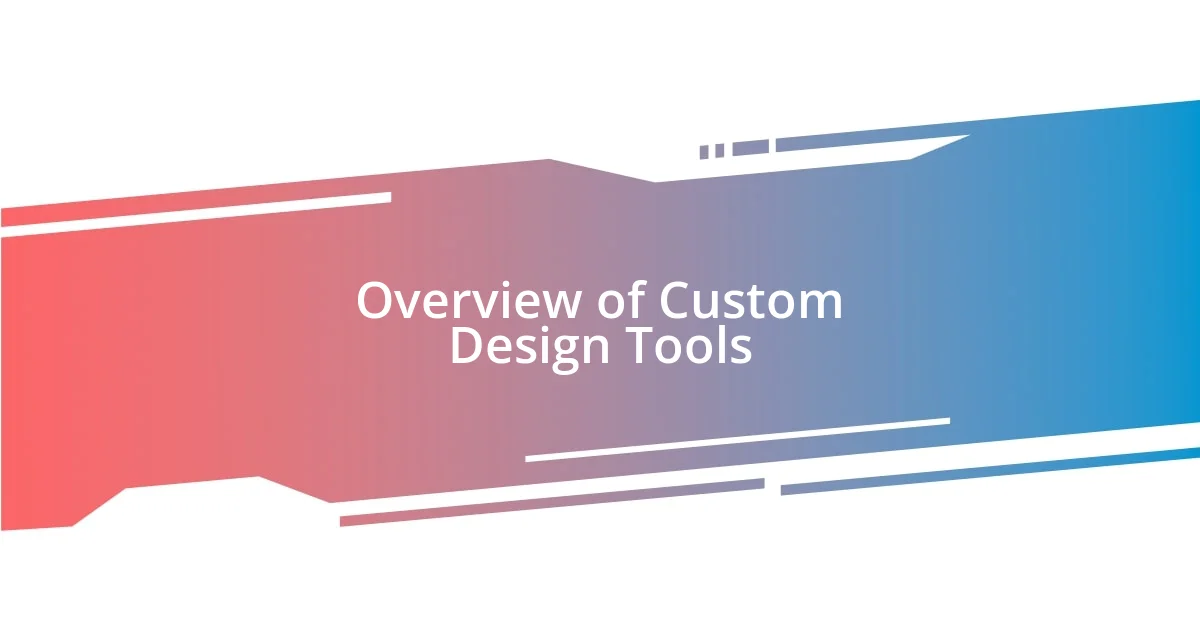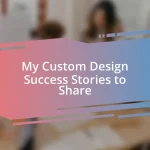Key takeaways:
- Custom design tools greatly enhance creativity and streamline the design process, offering features that foster exploration and collaboration.
- Essential features of design tools include intuitive user interfaces, real-time collaboration capabilities, and extensive asset libraries, which collectively improve user experience.
- Utilizing the right tools, such as Procreate or Figma, can significantly boost design skills and confidence, while engaging with online communities enhances the learning experience.

Overview of Custom Design Tools
When it comes to custom design tools, I often find myself reflecting on how they have revolutionized my creative process. Simple software applications can offer a myriad of features that streamline design tasks, allowing for greater exploration and expression. Have you ever used a tool that completely transformed your workflow? I remember the first time I discovered a vector graphics editor; it was like unlocking a new level of creativity.
The breadth of options available today can be truly overwhelming. From basic sketching applications to sophisticated 3D modeling software, each tool has its unique strengths. For example, I once used a robust digital design platform for a project, and its collaboration features turned a complex task into a seamless experience. Isn’t it incredible how technology can foster teamwork and innovation across distances?
Ultimately, the best custom design tools are those that resonate with you personally. I find myself gravitating towards tools that marry functionality with inspiration. Think about it: when a tool speaks to your creative instincts, the possibilities become endless. What tools do you reach for when the spark of inspiration strikes? Each tool can be a loyal companion on your design journey, shaping the way your ideas come to life.

Essential Features of Design Tools
Design tools should possess certain essential features that enhance the user experience and elevate the creative process. For me, a strong user interface (UI) is paramount; it’s the first interaction I have with the tool and can set the tone for the entire project. I remember struggling with a software that had a cluttered layout, and it drained my motivation. Having an intuitive design makes all the difference—it encourages exploration instead of frustration.
Collaboration capabilities are another feature I hold dear. When I worked on a team project recently, our design tool’s live editing function allowed us to brainstorm in real-time. The thrill of seeing each other’s updates instantly was energizing, turning what could have been a scattered process into a fluid creative jam session. How often do you find that sharing ideas instantly can spur even more inspiration? It’s a game changer when everyone in the team can contribute their unique flair without missing a beat.
Lastly, an extensive library of resources and assets is critical for efficient design work. I recall diving into a new project where every element I needed was just a drag-and-drop away from the tool I was using. It felt like having an endless toolbox at my fingertips, allowing me to elevate my vision without getting bogged down in sourcing materials. Isn’t it exciting when the right features come together to transform a vision into a tangible reality?
| Feature | Description |
|---|---|
| User Interface | Intuitive and easy to navigate, essential for maintaining focus and motivation. |
| Collaboration Tools | Real-time editing and feedback mechanisms that enhance team synergy and creativity. |
| Asset Libraries | Rich resources of templates, images, and components available for quick insertion into projects. |

Popular Graphic Design Software
When it comes to popular graphic design software, several names consistently surface, each with its own charm and functionality. I’ve dabbled with a few of these tools, and they each bring a unique experience to the table. It’s fascinating how software like Adobe Creative Suite, with its powerhouse of tools, can cater to a variety of design needs. I vividly recall when I first used Adobe Illustrator for a logo design project; the precision I found in vector creation was exhilarating. Once I got the hang of the pen tool, I felt like an artist sketching my ideas into reality.
Here’s a quick look at some of the widely acclaimed graphic design software options that many of us turn to:
- Adobe Creative Suite: A set of powerful tools including Photoshop, Illustrator, and InDesign, great for everything from photo editing to layout design.
- CorelDRAW: Valued for its user-friendly interface, ideal for vector illustrations and designs.
- Canva: A favorite among beginners and non-designers for its ease of use and extensive template library.
- Sketch: Particularly popular for web and mobile app design, known for its collaborative features.
- Affinity Designer: A cost-effective alternative to Adobe, loved for its robust vector and raster tools.
Each software speaks to different aspects of creativity, and knowing which one aligns with your style can be remarkably empowering. Have you ever felt that spark of connection with a tool that made you want to create more? I know I have, especially when exploring the vibrant possibilities of these programs.

Best Tools for Illustration
Finding the right tools for illustration can dramatically shape your creative journey. One standout for me is Procreate. Its versatility and intuitive touch interface make drawing feel so fluid and natural. I remember the first time I tried it—I felt like my ideas could pour right out of my fingertips onto the screen. Suddenly, sketching was less of a chore and more of a joy. Have you ever had that moment where a tool just clicks, and your creativity flows effortlessly?
Another tool I absolutely love is Adobe Fresco. Designed specifically for digital painting, it brings watercolor and oil painting capabilities to life in ways that feel incredibly authentic. I still recall creating a textured landscape that evoked emotion in me—I could almost feel the breeze on my skin as I painted. The live brushes mimic real-world techniques, which can be downright mesmerizing. Have you ever found yourself getting lost in the brushwork, completely absorbed in the moment?
Lastly, I can’t talk about illustration tools without mentioning Clip Studio Paint. This software truly shines with its comic and manga capabilities. I had the opportunity to experiment with it while working on a storyboarding project, and what impressed me most was the tracking of perspective and panel layouts. The ease with which I could shift between various tools allowed my storytelling to flow seamlessly. Do you ever wonder how the right tools can enhance not just your artwork, but also your entire creative process? I constantly find that the tools I choose often define the essence of what I create.

Enhancing Design Skills with Tools
Using the right design tools can significantly boost your skills and confidence as a creator. I’ve found that each new software I embrace unlocks different facets of my creativity. For instance, when I first tried Figma for collaborative design projects, it was like a light bulb went off; its real-time feedback feature transformed how I approached teamwork. Have you ever experienced that rush of excitement when you realize a tool perfectly enhances your workflow?
Moreover, I believe that exploration is key to enhancing design skills. When experimenting with various tools, I stumbled upon Affinity Photo. The first time I manipulated an image’s lighting and color grading, it felt like I was painting with light itself. I vividly recall how revitalizing it was to see a dull photograph turn into a vibrant visual story. It’s fascinating how immersing ourselves in learning a new tool can open up doors we didn’t even know were there. Have you had a similar experience, where a simple tool made you see the endless possibilities ahead?
Finally, let’s not forget about how online resources and communities can amplify our design journey. Joining forums and following tutorials not only sharpens our technical skills but also provides a sense of camaraderie. I remember connecting with fellow designers through social platforms; sharing tips on using Behance inspired me to push my creative boundaries further. It’s incredible how collaboration and support can spark inspiration—what if the next tool or technique you discover could elevate your work to new heights? The thought alone makes the journey of discovery all the more exciting.















